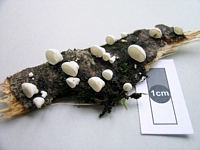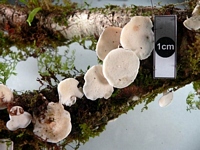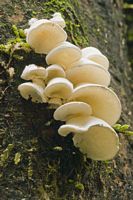|
 Gloeoporus phlebophorus Gloeoporus phlebophorus
SynonymsPolyporus phlebophorus
Polyporus nivicolor
BiostatusPresent in region - Indigenous. Non endemic
Images (click to enlarge)
Owner: J.A. Cooper | 
Owner: P.K. Buchanan | 
Caption: Details: growing about 100 cm up the side of growing beech tree of about 25 cm diameter. Size - the largest specimen was about 15 mm wide at the bottom, smaller ones alongside. In the area they seemed quite common, it was just at the beginning of a popula
Owner: Richard Studholme | 
Caption: Gloeoporus phlebophorus x 600, spores x 1200. Section through part of a dissepiment of Gloeoporus phlebophorus showing generative hyphae cemented together, merulioid type of hymenial layer with a persistent palisade of basidia and paraphyses and allantoid
Owner: Cunningham, G.H. | |
Article: Cunningham, G.H. (1965). Polyporaceae of New Zealand. New Zealand Department of Scientific and Industrial Research, Bulletin 164: 304 p. Wellington:.
Description: Hymenophore annual, ceraceous, solitary or caespitose from a common base, attached by a narrow lateral base or pendent from an umbo. Pilei conchate, spatulate, campanulate, or applanate, 0.5-3.5 cm wide, 0.5-2 cm radius, 1-2 mm thick; pileus surface white, drying cream, glabrous, even or sometimes obscurely radiately sulcate; cortex to 40 µm thick, a close palisade of partly cemented hyphae with rounded ends; margin acute, inturned, entire or crenate when old; hymenial surface plane or concave, even, white, drying cream. Pores white in section, round or angular, 6-7 per mm, 100-150 µm diameter, 0.2-0.5 mm deep; dissepiments 50-150 µm thick, most about 100 µm, slightly tapering, apices delicately velutinate. Context white, 0.25-1 mm thick, of densely intertwined hyphae, separated from the pores by a delicate layer of wood coloured intertwined gelatinised hyphae; generative hyphae 6-10 µm diameter, 5-6 µm in dissepiments, lumena 2-3 µm wide, freely branched, septate, with clamp connections. Hymenial layer to 15 µm deep, a dense permanent palisade of basidia and paraphyses. Basidia subclavate or subcylindrical, 6-8 x 2.5-3 µm bearing 2-4 spores; sterigmata erect, to 3 µm long. Paraphyses subcylindrical 5-7 x 2-2.5 µm. Spores allantoid, 3-3.5 x 1-1.25 µm, walls smooth, hyaline, 0.1 µm thick.
Habitat: Bark and decorticated wood of fallen branches, associated with a white rot.
Distribution: New Zealand, Australia, Java.
Notes: Plants are commonly applanate or conchate, attached by a narrow lateral base, solitary or in small groups arising from a common base. In some collections they are attached by a narrow vertex; in one they are pezizaeform and growing upon the surface of a fallen log, attached by stem-like. bases. In microfeatures all are identical. The Victorian collection has pores slightly larger (5-6 per mm), but agrees in other features. A conspicuous cortex is present, formed from a palisade of erect hyphae which, because of unequal length, give to the surface a peculiar dull appearance although it is glabrous. Plants are hard and horny when dry, owing to the presence of mucilage encrusting walls of the context hyphae, dissepiments and hymenial layer, and of masses of mucilage lying between them. P. imporcatus is identical with some of the collections from New Zealand, even to the allantoid spores. They are not globose, as was claimed by Lloyd, who confused mould spores with those of the species.
Article: Cunningham, G.H. (1948). New Zealand Polyporaceae. 3. The genus Polyporus. New Zealand Department of Scientific and Industrial Research, Plant Diseases Division, Bulletin 74: 39 p.
Description: Hymenophore annual, solitary or growing caespitose from a common base, laterally attached
by a short stem 3-4 mm. x 2-4 mm., sometimes growing from a stem-like elongation of the
upper surface, occasionally dimidiate and attached by a broad base, firm but brittle, entirely
white when fresh, drying cream. Pileus shell-shaped, spathulate, bell-shaped or occasionally
applanate, 1-3.5 cm. x 1.5-2 cm. x 1-2 mm.; surface white, becoming cream, smooth, dull,
sometimes obscurely sulcate, cuticle 30-40 µ thick, of compacted hyphae with ends upturned
and arranged in a close palisade; margin thin, acute, interned, entire or when old crenate or
toothed; hymenial surface plane or concave, even, white, drying cream, dissepiments not
toothed. Context white, 0.25-1 mm. thick, densely woven, separated from the pores by a
delicate wood-coloured woven layer; generative hyphae 6-10 µ thick, lumen 2-3 µ, freely
branched, septate, staining, clamp connections present, small. Pores round or angular, 0.2-0.5
mm. deep, white in section, 100-150 µ diameter, or 6-7 per mm.; dissepiments 50-150 µ
thick, mostly 100 µ, of woven mainly parallel hyphae, slightly tapering, apex delicately
velutinate. Basidial type merulioid, basidia cylindrical, 6-8 x 2-3 µ, arranged in a dense
persistent palisade. Spores allantoid, 3-3.5 x 1-1.5 µ, smooth. hyaline.
Habitat: Growing on bark and decorticated wood of dead branches, usually solitary,
sometimes caespitose, occasionally dimidiate.
Distribution: New Zealand.
Notes: The species is not closely related to others in this region possessing a monomitic hyphal
system. It may be recognised readily by the merulioid basidial type, allantoid spores, glassy
thick-walled intricately woven hyphae, definite though delicate cuticle, and white pileus. The
lateral stem may be reduced to an expansion of the base, or lacking when plants are dimidiate
and sometimes imbricate.
|